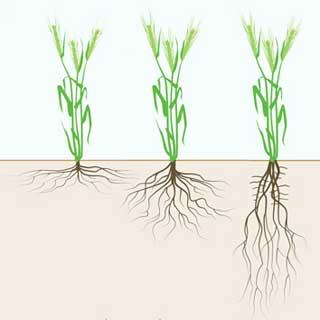Roots for Sustainability
Published on 30 July 2013 in Sustainability and Communities , Climate, water and energy , Food, health and wellbeing

Introduction
Plants provide food, fuel, fibre, medicines and industrial materials. They provide almost all the dietary energy for the world’s population and deliver most of their vitamins and minerals (Figure 1). In turn, plants must acquire the water and mineral elements, essential to their yield and nutritional quality, through their root system.
Major fluxes of all elements occur through plant roots and these affect global cycles of, for example, carbon, nitrogen and phosphorus (Figure 2). Thus, the roots of plants have a significant role to play in sequestering carbon below ground, reducing the emissions of greenhouse gasses, and preventing the pollution that can be associated with the misuse of fertilisers. Plant roots also have a role in sustaining fertility of soils, by stabilising them physically, improving their structure, and driving microbial processes. An understanding of the interactions between roots and the soil is fundamental to food security, human nutrition and environmental sustainability.
Key Points
- Plants provide almost all the dietary energy, and most of the vitamins and minerals, for the world’s population (Figure 1).
- Interactions between roots and soil are fundamental to biogeochemical cycles and to both crop yield and nutritional quality of produce (Figure 2).
- The importance of plant roots for environmental sustainability and food security are important considerations for national and international policy.
- We are studying how roots capture water and nutrients and how they adapt to adverse soil conditions.
- By combining physiological insight, mathematical modelling, and crop genetics we are producing crop root systems better suited to sustainable agroecosystems (Figure 3).
Figure 1 (PDF file 226KB): Contribution of terrestrial plant products, terrestrial animal products and marine products to (A) the total quantity, dietary energy and protein, (B) mineral elements and (C) vitamins of the world’s food supply.
Adapted from White et al. (2013) Annals of Botany (doi:10.1093/aob/mct123).
Research Undertaken
Our interdisciplinary research examines below ground interactions between roots and soil, focusing on root architecture and rhizosphere processes. We study nutrient and water capture by roots, beneficial interactions between plants and micro-organisms, and the adaptations of roots to soil compaction, drought and water-logging.
Figure 2 (PDF file 608KB): Global fluxes of (A) carbon, (B) nitrogen and (C) phosphorus through different compartments of the environment
Adapted from White et al. (2013) Annals of Botany (doi:10.1093/aob/mct123).
We have developed techniques for precision phenotyping of root traits and have constructed mathematical models, linking plant traits to resource use efficiency. This allows us to design root ideotypes (ideal attributes of a plant root system) for sustainable agroecosystems. Knowledge of these ideotypes allows us to streamline studies to identify the genes controlling beneficial root traits and the development of molecular markers for breeding. This research is being translated into the development of new varieties for higher-yielding, lower-input agricultural systems.
The research is supported by a number of stakeholders including the Scottish Government, UK Government Research Councils and the European Union. Work supported by RESAS through Theme 3 (Environmental Change – Land Use) focuses on characterising below ground interactions between roots, soils and microbes and investigating how they can be manipulated to maximise crop yield while minimising potential environmental damage. Work supported by the BBSRC Crop Improvement Research Club aims to develop simple, low-cost, high-throughput, root phenotyping platforms for screening root system architectures of arable crops to identify root traits correlated with crop establishment and commercial yield. While work supported by the European Union (for example, NUE Crops; EURoot) aims to capitalise on our mathematical models, phenotyping platforms and genetic resources to improve our understanding of nutrient acquisition, storage and utilisation by crops, and the genetic basis of water and nutrient use efficiencies in key crops such as cereals, brassicas, and potatoes.
Figure 3 (PDF file 86KB): Modelling the effects of root branching pattern and heterogeneity has implications for the acquisition of water and mineral elements and allows the design of root ideotypes for sustainable agroecosystems
Courtesy of Lionel Dupuy, James Hutton Institute.
Policy Implications
The need to reduce agricultural inputs, GHG emissions, and losses of mineral elements to the environment is implicit in many recent policy documents. These policy documents allow compliance with current national and international legislation.
For example:
- EU Water Framework Directive
- EU Nitrates Directive
- Low Carbon Scotland Initiative
- Climate Change (Scotland) Act 2009
Sustainable intensification of crop production can be delivered through breeding of crops with root traits adapted to their local soil environment. New crop varieties with improved root systems will make better use of water and mineral elements and, thereby, help reduce inputs and minimise pollution. Reducing the use of fertilisers can help towards meeting Scotland’s energy efficiency targets (Climate Change (Scotland) Act 2009), and improve water quality by contributing to N management strategies for nitrate vulnerable zones (NVZs) and P-fertiliser management.
Authors
Philip J. White, James Hutton Institute philip.white@hutton.ac.uk
Timothy S. George, James Hutton Institute tim.george@hutton.ac.uk
Lionel X.Dupuy, James Hutton Institute lionel.dupuy@hutton.ac.uk
Topics
Sustainability and Communities , Climate, water and energy , Food, health and wellbeing







